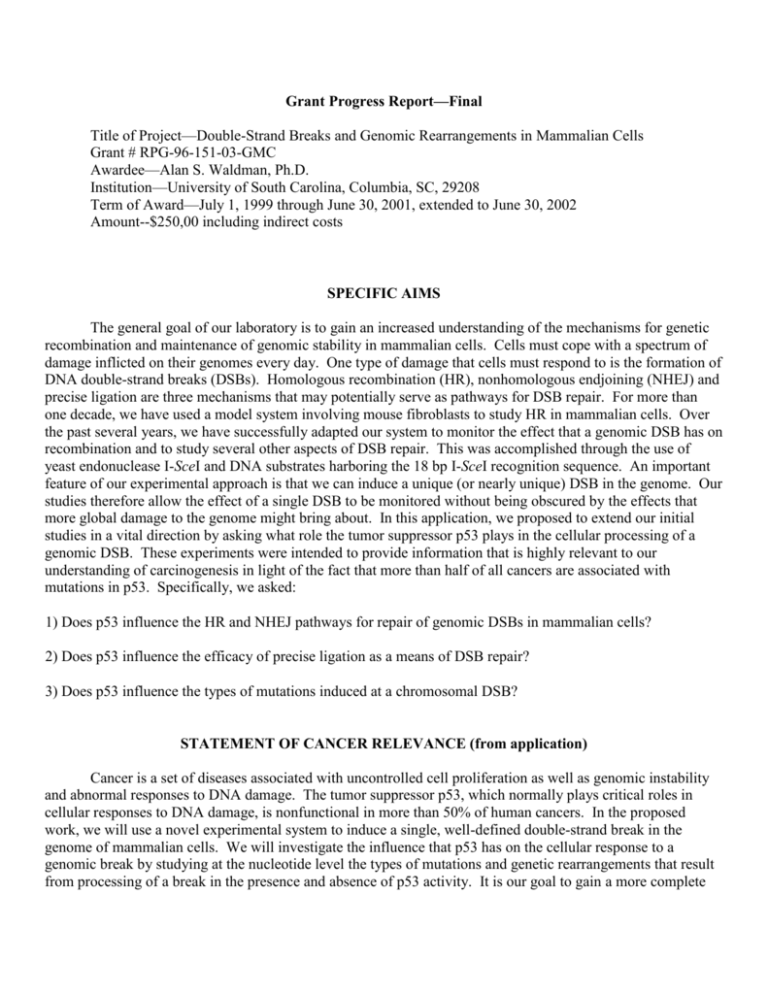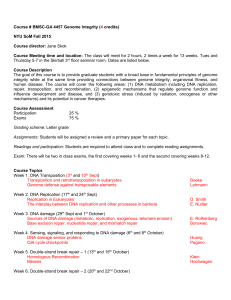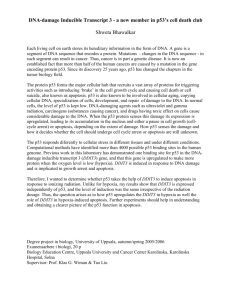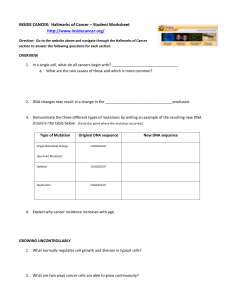STATEMENT OF CANCER RELEVANCE (from application)
advertisement

Grant Progress Report—Final Title of Project—Double-Strand Breaks and Genomic Rearrangements in Mammalian Cells Grant # RPG-96-151-03-GMC Awardee—Alan S. Waldman, Ph.D. Institution—University of South Carolina, Columbia, SC, 29208 Term of Award—July 1, 1999 through June 30, 2001, extended to June 30, 2002 Amount--$250,00 including indirect costs SPECIFIC AIMS The general goal of our laboratory is to gain an increased understanding of the mechanisms for genetic recombination and maintenance of genomic stability in mammalian cells. Cells must cope with a spectrum of damage inflicted on their genomes every day. One type of damage that cells must respond to is the formation of DNA double-strand breaks (DSBs). Homologous recombination (HR), nonhomologous endjoining (NHEJ) and precise ligation are three mechanisms that may potentially serve as pathways for DSB repair. For more than one decade, we have used a model system involving mouse fibroblasts to study HR in mammalian cells. Over the past several years, we have successfully adapted our system to monitor the effect that a genomic DSB has on recombination and to study several other aspects of DSB repair. This was accomplished through the use of yeast endonuclease I-SceI and DNA substrates harboring the 18 bp I-SceI recognition sequence. An important feature of our experimental approach is that we can induce a unique (or nearly unique) DSB in the genome. Our studies therefore allow the effect of a single DSB to be monitored without being obscured by the effects that more global damage to the genome might bring about. In this application, we proposed to extend our initial studies in a vital direction by asking what role the tumor suppressor p53 plays in the cellular processing of a genomic DSB. These experiments were intended to provide information that is highly relevant to our understanding of carcinogenesis in light of the fact that more than half of all cancers are associated with mutations in p53. Specifically, we asked: 1) Does p53 influence the HR and NHEJ pathways for repair of genomic DSBs in mammalian cells? 2) Does p53 influence the efficacy of precise ligation as a means of DSB repair? 3) Does p53 influence the types of mutations induced at a chromosomal DSB? STATEMENT OF CANCER RELEVANCE (from application) Cancer is a set of diseases associated with uncontrolled cell proliferation as well as genomic instability and abnormal responses to DNA damage. The tumor suppressor p53, which normally plays critical roles in cellular responses to DNA damage, is nonfunctional in more than 50% of human cancers. In the proposed work, we will use a novel experimental system to induce a single, well-defined double-strand break in the genome of mammalian cells. We will investigate the influence that p53 has on the cellular response to a genomic break by studying at the nucleotide level the types of mutations and genetic rearrangements that result from processing of a break in the presence and absence of p53 activity. It is our goal to gain a more complete understanding of how mammalian cells normally respond to chromosomal damage and how this response may be compromised in cancer cells. In so doing, we hope to make important contributions to our basic understanding of the complex interrelationships between DNA repair, genomic stability, and carcinogenesis. SUMMARY OF PROGRESS: We successfully completed and published studies (1) using a chemical inhibitor of p53 called pifithrin-alpha in which we were able to show that p53 plays a role in high-fidelity double-strand break repair but plays little or no role in low-fidelity (error-prone) repair. Our novel work established an additional mechanism by which p53 may normally serve to stabilize the genome, namely, by promoting accurate DNA repair. Our work also “raised a flag” regarding the proposed clinical use of pifithrinalpha as a means for lessening the damage to normal cells inflicted by chemotherapy. Although it is true that inhibition of p53 by pifithrin protects normal cells from p53-dependent cell death in response to chemotherapeutic agents, our work demonstrated that this chemical inhibitor corrupts DNA repair pathways and suggests the possibility that use of this inhibitor may result in the production of genetically abnormal cells due to failure of cells to correctly repair DNA damage. In our studies, we observed that inhibition of p53 did not affect the size of genomic deletions associated with repair of chromosome breaks and in general we did not obtain any evidence that p53 influences the nature of mutations associated with repair of breaks. We also were not able to detect any influence of p53 on homologous recombination rate although we did obtain some intriguing results that suggest that inhibition of p53 may result in an increased rate of recombination between DNA sequences sharing limited homology. These latter results imply that p53 may help to prevent abnormal genomic recombination events. Further studies will be needed to confirm these initial results. We also completed conceptually related work in the area of genome stability in which we showed that certain sequence motifs in the mammalian genome are intrinsically prone to genetic rearrangements (2). Such recombination hotspots in the genome could conceivably nucleate deleterious rearrangements that could ultimately play a role in carcinogenesis. We intend, in future studies, to examine the influence of p53 on the activity of unstable sequence motifs. Finally, we completed additional work on DNA repair and genomic stability and were able to show that DNA sequences (exogenous and endogenous) are often captured at sites of chromosomal breakage in the mammalian genome (3, 4) Our work suggested that chromosome breaks may stimulate transposition of retrotransposable elements into break sites. The movement of such genomic elements has been postulated by some to play a possible role in cancer and other genetic disorders. PUBLICATIONS 1. Lin, Y., Waldman, B.C., and Waldman, A.S.(2003) Suppression of High-Fidelity Double-Strand Break Repair in Mammalian Chromosomes by Pifithrin- , a Chemical Inhibitor of p53, DNA Repair 2: 1-11 (continued on next page) PUBLICATIONS (continued) 2. Waldman, A.S., Tran, H., Goldsmith, E.C., and Resnick, M.A. (1999) Long Inverted Repeats are an At-Risk Motif for Recombination in Mammalian Cells, Genetics 153:1873-1883 3. Lin, Y., and Waldman, A.S. (2001) Capture of DNA Sequences at Double-Strand Breaks in Mammalian Chromosomes, Genetics 158:1665-1674 4. Lin, Y., and Waldman, A.S. (2001) Promiscuous Patching of Broken Chromosomes in Mammalian Cells with Extrachromosomal DNA, Nucleic Acids Res. 29: 3975-3981).







